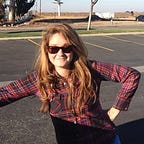Perception and the Apple Store
Last month, Apple opened their new store in Union Square in San Francisco. You’ve probably seen tons of articles by now about the architectural feats undertaken by Foster + Partners — everything from 42' glass doors to floating stairs. I recently visited the store and was struck by how many of the architectural, experience, and design features in the store closely mirror the features I see in compelling images of all kinds.
When everyone zigs, Apple zags
With 69% of American adults shopping online each month, retail companies really need to reinvent a reason to get customers into a physical store. Apple has found that reason. They’ve created a community gathering space, complete with workshops, events, free wi-fi, and an outdoor plaza that preserves a 1970 bronze fountain by San Francisco artist Ruth Asawa.
“Apple stores may not generate anywhere near the revenue of the company’s online counterpart. Yet for the last 15 years, they have acted as Apple’s real-world footprint, a way to set apart how it communicates with customers and leaves its mark on cities around the world,” said Nick Statt in his coverage of the Apple Union Square opening in The Verge.
Buying an Apple product in person is almost an afterthought in this community space. As e-commerce shifts from “search” to “browse,” Apple has responded by re-imagining their physical store as the perfect foundation for that experience.
It’s how Apple has done this that I find particularly interesting.
Apple has figured out the human perceptual system
In addition to figuring out physical retail in an e-commerce world, Apple’s new store makes it clear that they’ve figured out the human perceptual system as well. They’re using the space and materials to elicit the curiosity and emotional response of the store’s visitors. We see the same perceptual plays that they’re using in their store in our image research as well.
Here are some of the features I found most striking.
Instability
Displays like the one above bring to mind the principle of instability. In the image above, it looks like the objects are about to fall off the wall, drawing you over to take a look.
Instability comes into play in the architectural features as well. The second floor appears to be hovering above the first. Connecting the two floors are a set of glass stairs that, at first glance, float unencumbered by supports from the first floor to the second.
Flowing water
Flowing water combines the power of brightness and glistening with the known curiosity-inducing feature of incompleteness. Apple has brought water into the store experience both through a waterfall on the plaza and through the restored bronze fountain by Ruth Asawa.
Faces
Humans love looking at faces. It is one of the strongest indicators of perceptual interest we see in images. Apple brings faces into their new store in two main ways.
Humans are so attuned to faces that a simple wooden ball with headphones on becomes personal. Apple plays with this by displaying headphones on perfectly spherical wooden balls. Our perceptual system fills in the gap, and we perceive the wooden ball as a face.
Apple brings faces into the store in another way, too: through their community focus. Bringing the community in — through open wall-sized doors and workshops in the outdoor plaza — means surrounding people with other people. Apple has designed not just their physical space, but the emotional space in their store.
Roundness
On a subconscious level, humans have a preference for soft, curved, rounded objects. Apple employs roundness in the wooden ball displays we saw above. The roundness continues in the detail from the circled heads to the circles that have plants growing out of them that expands across one of the walls bounding the plaza.
Unexpectedness
Ruth Asawa’s bumpy, bronze fountain as a counterpoint to the cool minimalism with sharp edges in much of the rest of the store. We see this in our human perception research as well. An unexpected object, motion, or facial expression invokes curiosity in the viewer, causing them to pause and try to reconcile what they’re seeing with their expectations.
Pops of color
Bright pops of color are another strong indicator of unconscious visual preference. Images with a region of bright color are undeniably eye-catching. Apple uses this technique throughout the store in their displays, but most effectively in the plaza where they’ve installed a 10' high rainbow sculpture (by San Francisco artist Laura Kimpton) on an otherwise monochromatic background.
Natural landscapes
Humans have a natural affinity for green spaces (see: the new fitness trend “forest bathing”). We’ve found that including natural landscapes in images can be predictive of an image that is unconsciously appealing.
Apple has incorporated greenness in a number of ways. The Genius Bar has been replaced by the Genius Grove, where Geniuses perch beneath massive potted ficus trees, ready to help customers with their hardware issues. Apple has also installed a living wall and a second set of potted trees in the plaza. Perhaps most ingenious is their inclusion of green space by way of reflection. The massive glass panels that comprise the front and back of the building reflect the store’s green surroundings (Union Square on one side, and the plaza on the other), creating a canvas for the changing imagery around the store.
Written in collaboration with Nicole Halmi
